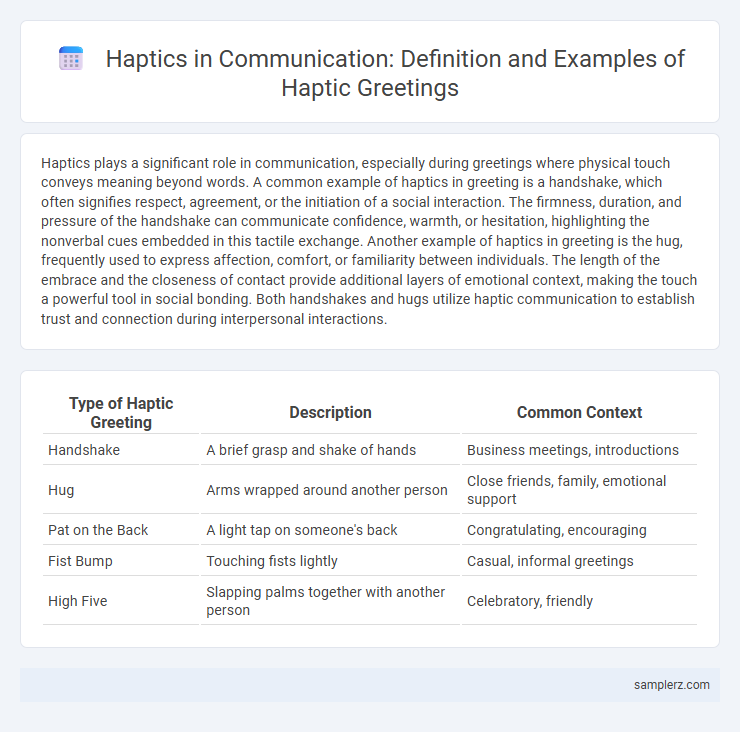Haptics plays a significant role in communication, especially during greetings where physical touch conveys meaning beyond words. A common example of haptics in greeting is a handshake, which often signifies respect, agreement, or the initiation of a social interaction. The firmness, duration, and pressure of the handshake can communicate confidence, warmth, or hesitation, highlighting the nonverbal cues embedded in this tactile exchange. Another example of haptics in greeting is the hug, frequently used to express affection, comfort, or familiarity between individuals. The length of the embrace and the closeness of contact provide additional layers of emotional context, making the touch a powerful tool in social bonding. Both handshakes and hugs utilize haptic communication to establish trust and connection during interpersonal interactions.
Table of Comparison
| Type of Haptic Greeting | Description | Common Context |
|---|---|---|
| Handshake | A brief grasp and shake of hands | Business meetings, introductions |
| Hug | Arms wrapped around another person | Close friends, family, emotional support |
| Pat on the Back | A light tap on someone's back | Congratulating, encouraging |
| Fist Bump | Touching fists lightly | Casual, informal greetings |
| High Five | Slapping palms together with another person | Celebratory, friendly |
Understanding Haptics in Communication
Haptics in communication involves tactile interactions like handshakes, hugs, or pats on the back, serving as powerful nonverbal cues that convey emotions and intentions without words. Studies show that a firm handshake can establish trust and confidence in professional greetings, while a gentle touch during social encounters may express empathy and warmth. Understanding these tactile signals enhances interpersonal connections by providing nuanced information beyond verbal communication.
The Role of Touch in Social Greetings
Touch plays a crucial role in social greetings by conveying warmth, trust, and empathy, often through handshakes, hugs, or pats on the back. These haptic interactions serve as nonverbal cues that establish connection and reinforce social bonds. Effective use of touch in greetings enhances interpersonal communication and fosters positive relationships.
Common Haptic Greetings Across Cultures
Haptics in greeting varies widely across cultures, with common examples including handshakes in the United States and Europe, bowing with a light touch on the forearm in Japan, and cheek kissing in many Latin American and Mediterranean countries. These physical gestures convey respect, warmth, and social connection, reflecting cultural norms and social hierarchies. Understanding these haptic greetings enhances cross-cultural communication and builds rapport in diverse social settings.
Handshakes: The Universal Greeting
Handshakes serve as a universal haptic greeting, conveying respect, trust, and agreement across diverse cultures and professional settings. This tactile gesture involves a firm yet brief grasp of another person's hand, facilitating nonverbal communication that establishes social connection and mutual understanding. Handshakes function as a critical component in first impressions, negotiation processes, and conflict resolution by reinforcing positive interpersonal relationships.
Hugs as Expressions of Warmth
Hugs serve as powerful haptic gestures in communication, conveying warmth, comfort, and connection without words. They activate the release of oxytocin, reducing stress and fostering trust between individuals. As expressions of affection, hugs strengthen social bonds and provide nonverbal reassurance in both personal and professional interactions.
Cheek Kissing in Greeting Rituals
Cheek kissing is a common haptic greeting ritual in many cultures, especially in Mediterranean and Latin American societies, symbolizing warmth and social bonding. This tactile gesture communicates trust, respect, and familiarity without spoken words. Variations in the number of kisses and the side to start demonstrate regional and cultural nuances in nonverbal communication.
Fist Bumps and High-Fives: Modern Touch Gestures
Fist bumps and high-fives are contemporary haptic gestures widely used in greetings to convey camaraderie and positive reinforcement. These touch-based interactions enhance social bonding by providing immediate, physical feedback that strengthens interpersonal communication. Their popularity in casual and professional settings demonstrates the growing role of haptics in modern nonverbal communication.
Bowing and Alternative Non-Touch Greetings
Bowing is a widely recognized haptic greeting, especially in East Asian cultures, where it conveys respect without physical contact. Alternative non-touch greetings such as hand waves, nods, and placing a hand over the heart have gained prominence worldwide, promoting hygiene while maintaining social connection. These non-verbal haptic cues effectively communicate warmth and respect in professional and social interactions.
The Psychology of Physical Contact in Greetings
Haptics in greetings, such as handshakes, hugs, and pats on the back, play a crucial role in conveying trust, warmth, and social bonding. Physical contact activates the release of oxytocin, a hormone that reduces stress and enhances feelings of connection and empathy. Understanding the psychological impact of touch in communication helps explain why tactile gestures are essential for establishing rapport and positive interpersonal interactions.
Navigating Haptic Greetings in a Post-Pandemic World
Haptic greetings such as handshakes and hugs have evolved significantly in a post-pandemic world, requiring increased awareness of personal boundaries and cultural differences. People now often opt for alternative gestures like fist bumps or elbow taps to maintain social connection while minimizing physical contact. Understanding these adaptations is crucial for effective communication and respectful interaction in diverse social and professional settings.

example of haptics in greeting Infographic
 samplerz.com
samplerz.com